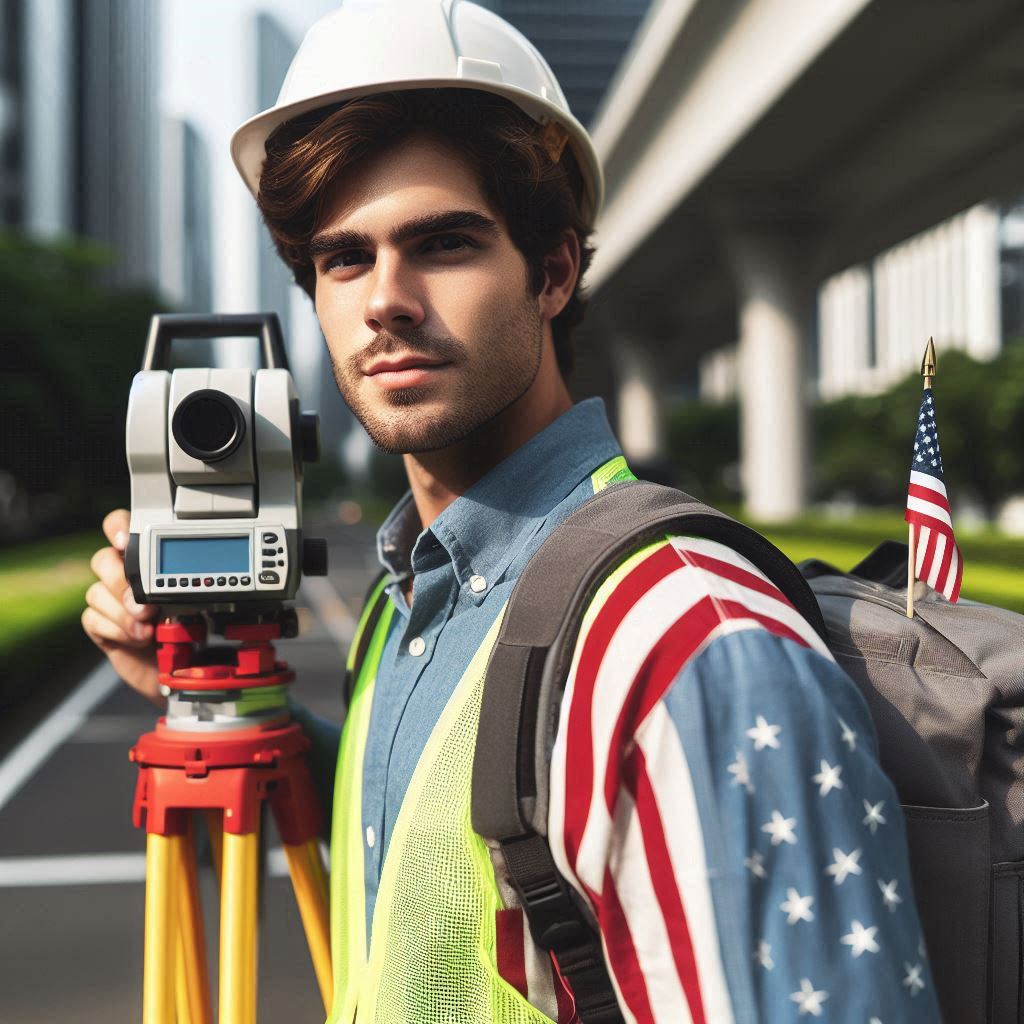Introduction
Safety is crucial for field surveying technicians due to the demanding and often hazardous environments in which they operate.
These professionals work in diverse and sometimes challenging conditions, including uneven terrain, construction sites, and remote locations.
Each of these environments presents specific safety concerns that must be addressed to prevent accidents and ensure technician well-being.
Field surveying technicians often encounter potential hazards such as uneven ground, which can lead to slips, trips, and falls.
Working near heavy machinery or traffic increases the risk of accidents, while exposure to extreme weather conditions like heat, cold, or storms can affect health and safety.
Electrical hazards also pose risks, especially when handling surveying equipment or working in areas with exposed wires.
In addition, technicians may face physical strain from carrying heavy equipment or performing repetitive tasks.
Understanding these risks and implementing appropriate safety measures are essential for maintaining a secure working environment.
Adhering to established safety protocols helps prevent injuries and supports the accurate completion of surveying tasks.
Prioritizing safety not only protects technicians but also enhances overall productivity and job satisfaction.
By being aware of and mitigating potential hazards, field surveying technicians can work more confidently and efficiently, ensuring both their safety and the quality of their work.
Conducting a pre-survey safety inspection
Check Equipment and Tools for Any Defects or Malfunctions
Before beginning any survey, thoroughly inspect all equipment and tools.
Ensure that instruments such as total stations, GPS units, and measuring tapes are functioning properly.
Check for visible defects like cracks or frayed cables. Test equipment to confirm accuracy and reliability.
Regular maintenance and calibration are vital to avoid malfunctions during fieldwork.
Reporting any issues immediately can prevent potential accidents.
Always carry spare parts or backup tools to address unexpected equipment failures.
Keeping equipment in good condition ensures both safety and efficiency on the job.
Ensure That Proper Safety Gear Such as Hard Hats, Gloves, and Safety Glasses Are Worn at All Times
Wearing the appropriate safety gear is crucial for protecting yourself from injuries.
Always wear a hard hat to shield against falling objects or accidental impacts.
Use safety glasses to protect your eyes from debris or hazards.
Gloves provide protection from sharp objects, chemicals, or rough surfaces.
Additionally, wear high-visibility clothing to make yourself easily seen, especially in areas with vehicle traffic or low light.
Ensure that all safety gear fits properly and is in good condition.
Regularly check and replace worn or damaged gear to maintain optimal protection.
Familiarize Yourself with Emergency Procedures and Evacuation Routes
Knowing emergency procedures and evacuation routes is essential for ensuring safety in the field.
Before starting work, review the site-specific emergency plans.
Identify the locations of first aid kits, fire extinguishers, and emergency exits.
Familiarize yourself with the nearest safe assembly points and evacuation routes.
Participate in emergency drills if available, and understand the protocol for reporting incidents.
Communicate emergency procedures to all team members and ensure they know how to respond in case of an emergency.
Being prepared and informed helps reduce panic and ensures a swift and organized response during critical situations.
By following these safety tips, field surveying technicians can work more safely and effectively.
Checking equipment regularly, wearing the proper safety gear, and being prepared for emergencies significantly reduce the risk of accidents.
Prioritizing these safety measures helps protect technicians and ensures the smooth completion of surveying tasks.
Safety is a shared responsibility; adherence to these practices contributes to a safer work environment for everyone involved.
Planning for unpredictable weather conditions
Stay Informed About the Weather Forecast
Before heading out for a survey, always check the weather forecast.
Weather conditions can change rapidly and impact the safety and efficiency of fieldwork.
Understanding the forecast helps in planning the survey to avoid hazardous conditions.
If severe weather like thunderstorms or extreme heat is expected, consider rescheduling the survey.
Regularly updating weather information during the day can also alert you to sudden changes.
This preparation helps prevent accidents and ensures you are adequately prepared for the conditions.
Carry Necessary Supplies
Equip yourself with essential supplies to handle various weather conditions.
Sunscreen is crucial for protecting your skin from harmful UV rays during sunny days.
Apply it regularly, especially if you are working for extended periods outdoors.
Carry plenty of water to stay hydrated, as fieldwork often involves physical exertion.
Dehydration can lead to fatigue and impaired performance.
Additionally, pack rain gear, such as waterproof jackets and pants, to stay dry during unexpected showers.
Having these supplies readily available helps you stay comfortable and focused on your tasks.
Have a Backup Plan for Severe Weather
Always have a backup plan in case of severe weather conditions.
Assess the weather forecast before starting your work and determine safe alternatives if conditions deteriorate.
This plan might include postponing the survey or moving to a safer location if bad weather occurs.
Establish clear communication channels with your team to coordinate any changes or updates in real-time.
Knowing your options in advance helps mitigate the impact of adverse weather on your work schedule and safety.
Incorporate safety checks into your routine to ensure preparedness.
Regularly review and update your backup plan based on seasonal weather patterns and specific project requirements.
This proactive approach minimizes the risk of encountering unsafe conditions and ensures that you can adapt quickly if weather conditions change.
Therefore, staying informed about the weather forecast, carrying necessary supplies, and having a backup plan are essential safety tips for field surveying technicians.
By following these guidelines, you can protect yourself from environmental hazards, ensure efficient fieldwork, and maintain a high level of safety throughout your surveying tasks.
Practicing safe driving habits
Observe Speed Limits and Traffic Rules When Traveling to and from Surveying Sites
Field surveying technicians often travel to various locations, making road safety crucial.
Observing speed limits and traffic rules is essential to ensure safe journeys to and from surveying sites.
Adhering to these regulations helps prevent accidents and promotes overall safety on the roads.
Always plan your route ahead of time and stay informed about any road conditions or closures that might affect your travel.
Following speed limits and traffic laws not only keeps you safe but also avoids legal issues and ensures timely arrival at your destination.
Avoid Distracted Driving Such as Using Mobile Phones While Behind the Wheel
Distracted driving significantly increases the risk of accidents and is particularly dangerous when operating a vehicle with heavy or sensitive equipment.
Avoid using mobile phones or engaging in other distractions while driving.
Ensure that your focus remains solely on the road and your surroundings. If you need to make a call or send a message, pull over safely before using your phone.
By staying attentive and minimizing distractions, you can significantly reduce the risk of accidents and ensure a safer driving experience.
Secure Equipment in the Vehicle to Prevent Shifting During Transit
Securing equipment in your vehicle is crucial for both safety and equipment protection. Unsecured equipment can shift during transit, causing distractions or even injuries.
Use appropriate straps, nets, or storage solutions to keep your equipment stable and secure.
Properly securing your gear not only protects the equipment but also prevents potential accidents caused by loose items moving around in the vehicle.
This practice helps maintain focus on the road and ensures that your equipment remains in good condition for effective use in the field.
In review, field surveying technicians should prioritize observing speed limits and traffic rules to ensure safe travel.
Avoiding distractions while driving and securing equipment in the vehicle are essential practices for maintaining road safety and preventing accidents.
By following these guidelines, technicians can create a safer working environment, minimize risks, and ensure the protection of both themselves and their equipment.
Read: Tips for Writing Environmental Engineering Reports
Setting up boundaries and warning signs
Clearly Mark Off Hazardous Areas with Caution Tape or Signs
In field surveying, marking off hazardous areas with caution tape or signs is crucial for ensuring safety.
Clearly visible caution tape alerts everyone to potential dangers, such as uneven terrain or active construction zones.
Use bright, reflective tape to ensure it is noticeable even in low-light conditions.
Place signs that clearly state the nature of the hazard and the required precautions.
This practice helps prevent accidents by warning team members and passersby about potential risks.
Regularly check and maintain these markings to ensure they remain effective throughout the duration of the project.
Properly marking hazardous areas is a fundamental step in creating a safer work environment and reducing the risk of injury.
Use Barricades to Prevent Unauthorized Access to Work Zones
Barricades are essential for controlling access to work zones and maintaining safety.
Install physical barriers around the perimeter of hazardous areas to prevent unauthorized entry.
These barricades should be sturdy and clearly marked with warning signs to alert individuals to stay away.
Use barriers such as fencing, cones, or barriers with flashing lights to ensure visibility.
Regularly inspect and secure these barricades to prevent them from being moved or tampered with.
Effective use of barricades helps manage traffic and restrict access, minimizing the risk of accidents and ensuring that only authorized personnel enter the work zone.
Implementing these measures protects both the team and the public from potential hazards.
Communicate with Team Members About Designated Safe Areas
Effective communication with team members about designated safe areas is vital for ensuring everyone‘s safety on-site.
Clearly define and communicate the locations of safe zones where workers can retreat in case of emergencies.
Mark these areas on site plans and ensure all team members are aware of their locations.
Conduct briefings at the beginning of each shift to remind workers about safety protocols and emergency procedures.
Use radios or other communication tools to relay any changes or updates regarding safe areas.
Encourage team members to report any safety concerns or hazards immediately.
Regular communication ensures that everyone is informed and prepared to act swiftly if needed, enhancing overall safety and reducing the likelihood of accidents.
In field surveying, marking hazardous areas with caution tape, using barricades, and communicating safe zones are key safety practices.
Properly marking hazards helps prevent accidents by warning individuals of potential dangers.
Barricades control access and keep unauthorized people away from dangerous zones, while clear communication ensures that all team members know where to find safety and how to respond in emergencies.
Implementing these safety tips helps create a secure work environment and protects everyone involved from potential risks.
Adhering to these practices ensures safer, more efficient field surveying operations and minimizes the chance of injury or accidents.
Read: Environmental Engineers in the Mining Industry

Ensuring proper ergonomics
Lift Heavy Objects with Proper Lifting Techniques
Lifting heavy objects correctly is vital to prevent strain and injury.
Always bend at the knees, not at the waist, when lifting.
Keep your back straight and use your legs to lift.
Grip the object securely and hold it close to your body.
Avoid twisting your torso while lifting; instead, pivot with your feet.
If an object is too heavy, seek assistance or use equipment like hoists or dollies.
Proper lifting techniques minimize the risk of back injuries and strains, allowing for safer handling of surveying tools and materials.
Transform Your Career Today
Unlock a personalized career strategy that drives real results. Get tailored advice and a roadmap designed just for you.
Start NowTake Regular Breaks to Rest and Stretch Muscles
Fieldwork can be physically demanding, making regular breaks essential for muscle health.
Schedule short breaks throughout the day to rest and recover.
During breaks, stretch your muscles to relieve tension and improve circulation.
Stretching helps prevent muscle stiffness and fatigue, enhancing your overall comfort and productivity.
Incorporate stretching exercises that target areas commonly strained during surveying, such as the back, shoulders, and legs.
By taking breaks and stretching regularly, you reduce the risk of overuse injuries and maintain better physical health during demanding work conditions.
Adjust Equipment Height and Angles to Maintain Good Posture During Work
Maintaining good posture is crucial for preventing musculoskeletal problems while using surveying equipment.
Adjust the height of your equipment to match your working height, reducing the need to bend or reach awkwardly.
Ensure that your work surface is at a comfortable height to avoid strain on your back and shoulders.
When using tools or instruments, position them at an angle that promotes a neutral wrist position.
Avoid prolonged periods of awkward posture or repetitive movements.
Regularly adjust your stance and work position to maintain ergonomic alignment and prevent discomfort or injury.
By following these safety tips, field surveying technicians can work more efficiently and with greater safety.
Proper lifting techniques protect against injury, while regular breaks and stretching maintain muscle health.
Adjusting equipment to fit your posture reduces strain and supports ergonomic practices.
Prioritizing these safety measures helps ensure a safer work environment and promotes long-term health and productivity in the field.
Read: Public Health and Environmental Engineering
Find Out More: Data Scientist vs. Data Engineer: Key Differences
Communicating effectively with team members
Establish Clear Communication Protocols Before Starting Any Surveying Tasks
Safety in field surveying depends heavily on effective communication.
Establish clear communication protocols before beginning any surveying tasks to ensure that all team members are on the same page.
Agree on how to relay critical information, such as changes in plans or emergency situations.
Designate primary and secondary communication methods, and ensure everyone understands these protocols.
This practice helps prevent misunderstandings and ensures that important updates are shared promptly.
Use Radios or Cell Phones to Stay in Contact with Team Members
Utilize radios or cell phones to maintain constant contact with your team members throughout the survey.
Radios are effective for quick, real-time communication, especially in areas with poor cell service.
They allow you to relay information instantly, which is crucial in case of sudden changes or emergencies.
Cell phones provide a backup communication method and can be used for sending detailed messages or coordinating logistics.
Regular check-ins using these devices ensure that all team members are aware of each other‘s status and any developments on the job site.
Inform Colleagues About Any Potential Hazards or Risks on the Job Site
Before starting work, inform your colleagues about any potential hazards or risks present at the job site.
Conduct a thorough site assessment to identify and document hazards, such as unstable terrain, heavy machinery, or environmental dangers.
Share this information with your team to prepare them for potential risks and ensure they follow safety precautions.
For example, if there are areas with heavy equipment, warn your team to maintain a safe distance.
Providing this information helps your team to be cautious and make informed decisions, reducing the risk of accidents or injuries.
In addition to these protocols, encourage a culture of open communication among team members.
Foster an environment where everyone feels comfortable reporting safety concerns or asking questions.
Regularly review and practice emergency procedures, so everyone knows how to respond effectively if an incident occurs.
Ensuring that safety protocols are well understood and followed can significantly reduce risks and enhance overall safety on the job site.
Generally, establishing clear communication protocols, using reliable communication tools, and informing colleagues about potential hazards are crucial for maintaining safety in field surveying.
By implementing these practices, you create a safer work environment, improve team coordination, and minimize the likelihood of accidents or misunderstandings.
Prioritizing effective communication and safety awareness contributes to a more efficient and secure surveying operation.
Read: Environmental Engineering Software and Tools
Explore Further: Interview Tips for Automotive Engineering Jobs
Handling hazardous materials with caution
Follow Proper Procedures for Handling and Disposing of Chemicals or Waste Materials
Handling and disposing of chemicals or waste materials correctly is crucial for field surveying technicians.
Always follow established protocols to ensure safety and environmental protection.
Begin by reading and understanding the safety data sheets (SDS) for each chemical.
These documents provide essential information on safe handling, storage, and disposal practices.
Use designated containers for storing and disposing of chemicals, and never mix different types of waste.
Improper disposal can lead to environmental contamination and legal issues.
Ensure you are aware of local regulations regarding hazardous waste disposal.
Dispose of chemicals at approved facilities to prevent harm to the environment.
By adhering to these procedures, you contribute to a safer work environment and help protect natural resources.
Wear Appropriate Personal Protective Equipment When Dealing with Hazardous Substances
Wearing the correct personal protective equipment (PPE) is essential when working with hazardous substances.
PPE acts as a critical barrier between you and potential hazards, reducing the risk of exposure.
Depending on the nature of the chemicals or materials, ensure you wear gloves, goggles, and respirators as specified in the SDS.
Inspect your PPE before each use to check for any damage.
Replace any defective equipment immediately to maintain safety standards.
Properly fitted PPE provides optimal protection and helps prevent injuries or health issues related to chemical exposure.
Make sure to follow manufacturer guidelines and safety recommendations for using and maintaining your PPE.
Avoid Direct Contact with Toxic Substances and Wash Hands Thoroughly After Handling
Avoiding direct contact with toxic substances is key to ensuring your safety.
Handle chemicals carefully using appropriate tools and equipment designed for safe manipulation.
If direct contact is unavoidable, follow safety procedures to minimize exposure.
After handling hazardous materials, wash your hands thoroughly with soap and water.
Scrub all areas of your hands and wrists for at least 20 seconds to remove any residues.
Hand sanitizers may not effectively remove all chemical residues, so thorough washing is essential.
Avoid touching your face, especially your eyes and mouth, before washing your hands to prevent accidental ingestion or irritation.
Proper hand hygiene is a crucial step in protecting yourself from harmful effects and maintaining overall safety.
In summary, following proper procedures for handling and disposing of chemicals, wearing the appropriate PPE, and avoiding direct contact with toxic substances are vital for safety in field surveying.
Always wash your hands thoroughly after handling hazardous materials to remove any residues.
By adhering to these safety guidelines, you protect both yourself and the environment, contributing to a safer and more effective surveying process.
You Might Also Like: Geotechnical Engineering Projects to Know
Conclusion
Safety precautions are paramount in field surveying to protect technicians from a wide range of potential hazards.
The nature of fieldwork exposes surveyors to various risks, including adverse weather conditions, heavy machinery, and challenging terrains.
Emphasizing safety measures is crucial to prevent accidents and ensure a secure working environment.
Each technician must prioritize safety in every aspect of their work to minimize risks and avoid injuries.
Field surveying technicians should always adhere to established safety protocols.
This includes wearing appropriate personal protective equipment (PPE) such as helmets, gloves, and high-visibility clothing.
Regularly inspecting equipment for maintenance issues and ensuring that all safety gear is in good condition are essential practices.
Being aware of environmental risks, such as unstable ground or hazardous wildlife, helps technicians avoid accidents and stay safe.
Continuous training and awareness are critical for maintaining a safe work environment.
Technicians should engage in regular safety training sessions to stay updated on best practices and emerging hazards.
Safety training should cover topics such as first aid, emergency response procedures, and proper handling of equipment.
By staying informed and prepared, technicians can respond effectively to unforeseen situations and reduce the likelihood of accidents.
[E-Books for Sale]
The Big Book of 500 High-Paying Jobs in America: Unlock Your Earning Potential
$19.99 • 500 High-Paying Jobs • 330 pages
Explore 500 high-paying jobs in America and learn how to boost your career, earn more, and achieve success!
See All 500 High-Paying Jobs of this E-Book
1001 Professions Without a Degree: High-Paying American Jobs You Can Start Now
$19.99 • 1001 Professions Without a Degree • 174 pages
Discover 1001 high-paying jobs without a degree! Unlock career tips, skills, and success strategies for just $19.99!




